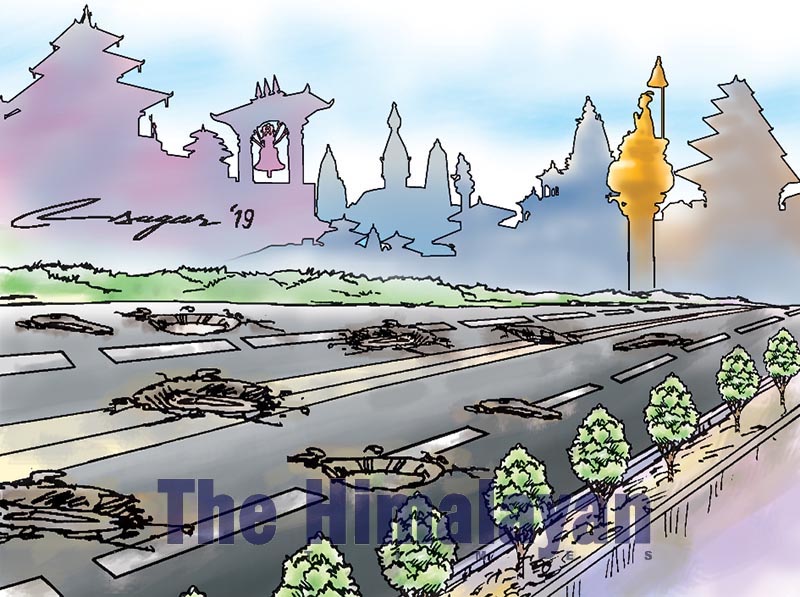Directive to cover potholes: Yet another deja vu
Toll roads must be introduced if road users want to enjoy a good ride. The provision of good public transport could also help bring down wear and tear significantly due to lesser number of vehicles on the streets
A fleeting glance through the roads of Nepal invariably reveals a maze of potholes, which have been something of an eyesore for all alike. At one time, the Pathlaiya-Birgunj road was so damaged that it appeared more like a field than a road, and people even planted rice to attract the attention of the government but to no avail. The prime ministers time and again in the past have issued directives to cover them up at different times. Prime Minister Oli has again drawn the attention of his concerned ministry towards them after the cabinet reshuffle, giving four months to cover them up.
The history of the roads goes back to times immemorial in this part of the world. Ramayan speaks of very beautiful roads in the erstwhile Ravana-reigned golden Lanka. In Buddha’s times, around 7th century BC, two roads — Uttara Pantha, or north bound, and Daxina Pantha, or south bound, existed in India. The north-bound road linked Nepal with the rest of the Indian subcontinent. It passed through Punjab, Rajasthan, Malawa, Mathura, then Panchal and Bideha and Magadh. This road is said to be 1,156 kilometres long, and it had a milestone every kilometre. The Vedic cities primarily consisted of three north-south and three east-west roads. Their echoes, however faint, can still be seen in several cities in the Kathmandu Valley and glaringly in Patan: the north-south bound roads being the Thapathali-Jawalakhel, Sankhamul-Lagankhel and Balkumari-Lagankhel roads and the east-west roads being the Pulchowk-Gwarko, Lagankhel-Sukuldhoka and Patan Dhoka-Balkumari roads.
Despite having such a long tradition of road buildings dating back to the mythical era, our highways are more of a hole-ways in view of the alcoves existing on their surface. An Unidentified Flying Object, with a moon landing campaign, mistakenly stepping in Nepal like Columbus landing in America in the quest of doing so in India may chant eureka as did Archimedes after solving the problem given by King Hiero II in view of the crater-like ditches on Nepali roads.
The condition of the roads has been dismal in other countries as well, but they were more so in the past than in the present. Chicago roads in 1910 lacked signage, stoplights, or crosswalks. Custom regulated the flow of traffic, not signage, and the most basic rule—keep to the right—often went unheeded. Pedestrians stood in the middle of the roadways to wait for arriving streetcars, crossing wherever they saw fit. Horse-drawn vehicles slowed the movement of streetcars, and drivers loaded and unloaded cargo wherever convenient. Horses also died on the streets—about 5,000 died in 1909 alone—which would cause delays until the Bureau of Streets removed the carcasses. But that was a century ago.
A Road Board was established in 2002 to provide sustainable funds for planned maintenance of roads with the objective of keeping the roads in serviceable condition. But scarce resources and the involvement of too many agencies in what is known as too many cooks spoiling the broth have been the twin problems. The annual budget required for the maintenance of roads in Nepal is Rs 85 billion, but it received only Rs 8 billion from the government in the year 2016/17. This budget has defied the laws of change by remaining unchanged this financial year even after four years when the total budget almost doubled to Rs 1,532 billion from Rs 819 billion in 2016/17. The annual extension of the road length by around 6.5 per cent further aggravates this funding problem. The Road Board works with different road agencies, one of which is the Roads Department. Its main responsibility is to look after strategic road networks. Besides, the Department of Local Infrastructure Development and Rural Roads, under the Ministry of Local Development, looks after the urban, district and local roads by coordinating with the District Development Committees and municipalities. For this, it has to work hand in glove with the Ministry of Physical Planning and Works.
Even though the budget allocated to the Road Boards is miniscule in size, the provision of Rs 163 billion for road infrastructure in the current year’s budget is quite significant as it comes to 10 per cent of the total budget of 1,532 billion. India in 2018 allocated Indian Rs 74,000 crores for the Ministry of Roads, which comes to only 2.5per cent of the total budget of 2,920,484 crores. It is then clear that the road users will have to pay in order to enjoy good road services. This can be done through the medium of toll roads. The other way can be the provision of good public transport, which will bring down wear and tear significantly due to lesser number of vehicles plying on the streets.
The Federal government should act as a facilitator, the provincial government as an implementer and the local government as an operator in this regard as we see in neighbouring India. But the actors forming the trinity appear to be involved in the blame game and at times even at daggers drawn to each other than coordinating properly. This has put the newly adopted Federal System in a crisis as the provincial government, though an important player, appears to be in the back bench more than in the field. This is also one of the main reasons for the inability to spend the developmental budget. If this continues, the potholes will only widen further.






